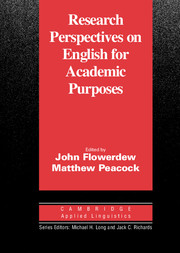Book contents
- Frontmatter
- Contents
- List of contributors
- Series editors' preface
- Preface
- I ISSUES IN ENGLISH FOR ACADEMIC PURPOSES
- II THE ENGLISH FOR ACADEMIC PURPOSES CURRICULUM
- Introduction to Part II
- 11 The EAP curriculum: Issues, methods, and challenges
- 12 Twenty years of needs analyses: Reflections on a personal journey
- 13 The curriculum renewal process in English for academic purposes programmes
- 14 Team-teaching in EAP: Changes and adaptations in the Birmingham approach
- 15 Does the emperor have no clothes? A re-examination of grammar in content-based instruction
- 16 The specialised vocabulary of English for academic purposes
- 17 Language learning strategies and EAP proficiency: Teacher views, student views, and test results
- 18 Issues in EAP test development: What one institution and its history tell us
- 19 Teaching writing for academic purposes
- 20 Reading academic English: Carrying learners across the lexical threshold
- 21 Incorporating reading into EAP writing courses
- 22 The development of EAP oral discussion ability
- 23 Second language lecture comprehension research in naturalistic controlled conditions
- 24 Designing tasks for developing study competence and study skills in English
- 25 Promoting EAP learner autonomy in a second language university context
- References
- Index
16 - The specialised vocabulary of English for academic purposes
Published online by Cambridge University Press: 05 October 2012
- Frontmatter
- Contents
- List of contributors
- Series editors' preface
- Preface
- I ISSUES IN ENGLISH FOR ACADEMIC PURPOSES
- II THE ENGLISH FOR ACADEMIC PURPOSES CURRICULUM
- Introduction to Part II
- 11 The EAP curriculum: Issues, methods, and challenges
- 12 Twenty years of needs analyses: Reflections on a personal journey
- 13 The curriculum renewal process in English for academic purposes programmes
- 14 Team-teaching in EAP: Changes and adaptations in the Birmingham approach
- 15 Does the emperor have no clothes? A re-examination of grammar in content-based instruction
- 16 The specialised vocabulary of English for academic purposes
- 17 Language learning strategies and EAP proficiency: Teacher views, student views, and test results
- 18 Issues in EAP test development: What one institution and its history tell us
- 19 Teaching writing for academic purposes
- 20 Reading academic English: Carrying learners across the lexical threshold
- 21 Incorporating reading into EAP writing courses
- 22 The development of EAP oral discussion ability
- 23 Second language lecture comprehension research in naturalistic controlled conditions
- 24 Designing tasks for developing study competence and study skills in English
- 25 Promoting EAP learner autonomy in a second language university context
- References
- Index
Summary
It is useful for teaching and learning to divide the vocabulary of English into four groups.
The high frequency words. These consist of around 2,000 word families. They are wide range high frequency words that are an essential basis for all language use. They include most of the 176 function words of English. Typically they provide coverage of around 80% of the running words in academic text. The classic collection of these is Michael West's (1953) General Service List of English Words (GSL).
The academic vocabulary. This consists of 570 words (Coxhead, 1998) that are reasonably frequent in a wide range of academic texts, but are not so common, although they do occur, in other kinds of texts. Because they provide coverage of around 8.5%–10% of the running words in an academic text, they are very important for learners with academic purposes. They make the difference between 80% coverage (one unknown word in every five running words) and 90% coverage (one unknown word in every ten running words).
Technical vocabulary. This differs from subject area to subject area. For any particular subject it consists of probably 1,000 words or less. It could provide coverage of up to 5% of the running words in a text.
The low frequency words. These consist of words that are typically vey narrow range and low frequency. Because of the topic of a particular text a small number may occasionally be quite frequent within that text. In general, they consist of words that occur once or twice and then will not be met again for along time. Of the 86,741 different word types in the 5,000,000 running word corpus used in the Carroll, Davies and Richman (1971) count, 40.4% occured only once in that corpus.
- Type
- Chapter
- Information
- Research Perspectives on English for Academic Purposes , pp. 252 - 267Publisher: Cambridge University PressPrint publication year: 2001
- 42
- Cited by

